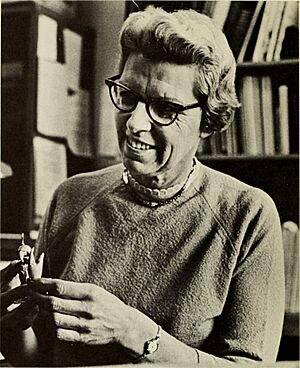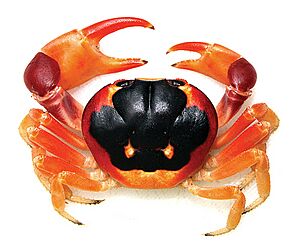Dorothy Bliss facts for kids
Quick facts for kids
Dorothy Bliss
|
|
|---|---|

Bliss c. 1969
|
|
| Born |
Dorothy Elizabeth Bliss
February 13, 1916 |
| Died | December 26, 1987 (aged 71) |
| Nationality | American |
| Alma mater |
|
| Scientific career | |
| Fields | Carcinology |
| Institutions | American Museum of Natural History |
| Thesis | The Neurosecretory System of Brachyuran Crustacea (1952) |
Dorothy Elizabeth Bliss (born February 13, 1916 – died December 26, 1987) was an important American scientist. She was a carcinologist, which means she studied crabs, lobsters, and other crustaceans. For over 30 years, she worked at the American Museum of Natural History in New York City.
Dr. Bliss was a pioneer in understanding how hormones control crustaceans. She was the main editor for a huge 10-volume book series called The Biology of Crustacea. She also wrote a popular book for everyone called Shrimps, Lobsters and Crabs. She was even the president of the American Society of Zoologists.
Early Life and Learning
Dorothy Bliss was born in Cranston, Rhode Island on February 13, 1916. Her parents were Orville Thayer and Sophia Topham Bliss. She went to Pembroke College, which is now part of Brown University. She earned her first degree in 1937 and a master's degree in 1942.
From 1942 to 1949, she taught at Milton Academy in Massachusetts. While teaching, she also studied for her PhD at Radcliffe College. She did her research with a scientist named John Henry Welsh.
Her PhD research focused on land crabs, especially a type called Gecarcinus lateralis. She studied how their eye stalks controlled their hormones. She earned her PhD in 1952.
Her Science Career
In 1956, Dorothy Bliss joined the American Museum of Natural History in New York City. She started as an assistant curator, which means she helped manage the museum's collection of invertebrates (animals without backbones). She became a full curator in 1967.
From 1974 to 1977, she led the department that studied fossils and living invertebrates. She retired in 1980 but continued to work as a curator emerita until 1987. She also taught at several universities, including Albert Einstein College of Medicine.
Dr. Bliss was famous for her new ideas about how hormones work in crustaceans. She was one of the first to show how a special part of their bodies, called the X-organ-sinus gland complex, releases hormones. These hormones control important things like molting (when crabs shed their shells) and how they balance salt and water in their bodies.
She did lab studies and also field research in places like Florida, Bermuda, and Bimini. She studied how land crabs dig burrows and lay eggs. She also looked at how moisture affects where different crab species live.
Dr. Bliss wrote over 40 scientific papers. She was also the main editor for The Biology of Crustacea. This was a very important 10-volume series published between 1977 and 1986.
She also worked on the editorial boards for several science magazines. These included American Zoologist and Natural History.
In 1982, she wrote a book for everyone called Shrimps, Lobsters and Crabs. This book was later reprinted in 1990. In 1972, Brown University gave her an honorary Doctor of Science degree. A special meeting was held in 1983 to honor her and another scientist, Lewis Kleinholz.
In her later years, Dr. Bliss lived in Wakefield, Rhode Island. She passed away from cancer in Providence, Rhode Island on December 26, 1987. She was 71 years old.


